



[TOKYO, Japan, 18 April 2011]
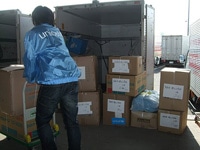 |
| © Japan Committee for UNICEF |
| A school in Yuriage, Natori City that was affected by the disaster. |
More than five weeks have passed since the Great East Japan Earthquake. The Japan Committee for UNICEF (JCU) is continuing assistance activities primarily in areas related to children—including assistance with reopening schools, establishing hotlines for infant nutrition consultations, etc.—while assessing the situation at the disaster area.
Last weekend (16 April), in Natori City, Miyagi Prefecture, an inauguration ceremony was held for the team that will distribute school supplies for the Back to School campaign, which is to kick off in earnest this week. The ceremony was held at the offices of the Miyagi Co-op, which is a longtime partner of JCU and has extended significant overall support for all aspects of JCU’s assistance activities, including supplies procurement and logistics.
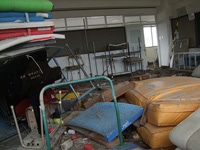 |
| © Japan Committee for UNICEF |
| Takata Daiichi Junior High School is being used as a shelter. |
The school supplies prepared by the inauguration ceremony were enough for 3,459 students at a total of 41 schools in Kesennuma, Ishinomaki, Shichigahama and Natori City. The same day, the necessary supplies for transferring activities from Natori City’s Yuriage Primary School and Yuriage Junior High School, which were totally destroyed during the tsunami, to Fujigaoka Primary School, which is located in the same city and where activities are to restart, were shipped. In addition, ethanol disinfectant was also shipped for kindergartens, primary schools and junior high schools located in all parts of Kesennuma City. Masks were also provided free of charge from the Miyagi Co-op. “I was very happy to participate in UNICEF activities and help to ensure that the children of Miyagi Prefecture are able to go to school.” said one of Miyagi Co-op staff. Thirteen staff from the Miyagi Co-op, who were also disaster victims, spent their weekends assisting with these activities.
A total of 713 boxes for Onagawa Town and 33 boxes for Kurihara City have already been shipped. There are also plans to ship 373 boxes to Shiogama City by 21 April.
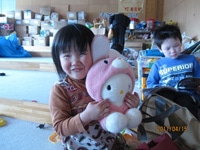 |
| © Japan Committee for UNICEF |
| Takata Daiichi Junior High School is being used as a shelter. |
Meanwhile, on 17 April in Ofunato City, Iwate Prefecture, UNICEF Children’s Mini Libraries arrived at the Ofuna District Public Hall, Suezaki Home Center, Akasaki Fishing Village Center and other locations. Early Childhood Development kits and recreation kits are also scheduled to be sent in the near future.
In addition, JCU volunteers are working daily to remove mud from kindergartens and other facilities. Five weeks have passed since the earthquake and now the mud has grown harder, requiring a tremendous amount of effort for removal. Needless to say work is not progressing according to schedule. Nevertheless, at Hirota Kindergarten in Rikuzentakata City, efforts to clear the mud have paid off as the kindergarten reopened its doors on 15 April. Approximately 80 children attended school on the first day.
The kindergarten’s principal, Ms. Fujikura, was delighted by the reopening, exclaiming, “Some of our teachers have lost their parents. Even so, they are still working to clean up the kindergarten on their spare time. Everyone was very happy when I informed the shelters and families that we were reopening.”
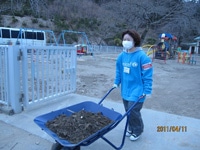 |
| © Japan Committee for UNICEF |
| Removing mud from a kindergarten in Rikuzentakata City. |
Haruka Kikuchi, a junior at Iwate Prefectural University, participated in the mud removal work at the kindergarten:
“I like children and was looking for a volunteer position related to children when I found the volunteer job at UNICEF. Today’s work consisted of physical labor, though, so I was a bit worried. Nevertheless, I am very happy, knowing that my assistance will contribute to bringing smiles to the faces of the children at the kindergarten. I hope the children are able to use the schoolyard to run around and play just like they used to.”
Rui Nomoto, a staff member from JCU that has been working in the disaster area in Iwate Prefecture, was surprised to see a situation at the disaster area that was much more serious than she had expected. At the same time, however, she says she was inspired by the strong spirits of the many disaster victims that lost their families and friends.
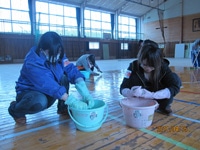 |
| © Japan Committee for UNICEF |
| Cleaning activities. |
Ms. Nomoto says, “Amidst these circumstances, locals are working tremendously hard with strong drive to reconstruct the schools as quickly as possible. The teachers also come to school every day—despite having much to do at home as well—and work towards reopening the school at the earliest possible stage. The disaster victims have it the worst, but they are still so considerate of us, telling us things like, ‘We feel like we really have your support, and that is what gives us the drive to move forward.’”
JCU will continue assistance activities, working to aid children of the disaster area in returning to school, kindergarten or preschool as early as possible.
| Receiving Prefecture |
Type of Emergency Supplies |
Arrival Date |
Quantity | Donating Company |
Comments |
|---|---|---|---|---|---|
| Miyagi | Water | 19 Mar. | 12,288 bottles |
VanaH Co., Ltd. | Two-liter plastic bottles |
| Fukushima | Water | 22 Mar. | 12,672 bottles |
VanaH Co., Ltd. | Two-liter plastic bottles |
| Miyagi | Underwear for boys and girls | 22 Mar. | 200,000 | ||
| Iwate | Underwear for boys and girls | 23 Mar. | 30,000 | ||
| Fukushima | Water | 23 Mar. | 4,680 bottles |
KIRIN MC DANONE WATERS Co., Ltd. | Two-liter plastic bottles |
| Miyagi | Children’s shoes | 23 Mar. | 10,000 pairs |
||
| Miyagi | RChildren’s diapers | 24 Mar. | 80 packs | P&G Japan | |
| Iwate | Children’s underwear | 24 Mar. | 9,700 | ||
| Fukushima | Water | 24 Mar. | 12,288 bottles |
VanaH Co., Ltd. | Two-liter plastic bottles |
| Iwate | Shoes | 26 Mar | 1,404 pairs | Achilles Corporation | |
| Iwate | Underwear for boys and girls | 27 Mar. | 28,266 | ||
| Iwate | Boots | 27 Mar. | 7,462 pairs | ||
| Iwate | Wipes | 28 Mar. | 1,200 | P&G Japan | For babies |
| Miyagi | Recreation kits Early Childhood Development kits |
2 Apr. | 50 of each | Procured from the UNICEF Supply Division | |
| Iwate | Recreation kits Early Childhood Development kits |
2 Apr. | 50 of each | Procured from the UNICEF Supply Division | |
| Miyagi | Book bags | 6 Apr. | 70 | Nihon New Bag Chain | |
| Iwate | Book bags | 6 Apr. | 340 | Seiban | |
| Miyagi | Schoolbags | 8 Apr. | 18,000 | Procured from the UNICEF Supply Division | |
| Iwate | Schoolbags | 8 Apr. | 18,000 | Procured from the UNICEF Supply Division | |
| Miyagi | Personal security buzzers (for crime prevention purposes) | 8 Apr. | 5,000 | ||
| Iwate | Personal security buzzers (for crime prevention purposes) | 8 Apr. | 5,000 | ||
| Fukushima | Water | 11 Apr. | 1,536 bottles | VanaH Co., Ltd. | Two-liter plastic bottles |
| Miyagi | Replenishments for recreation kits | 12 Apr. | 60 sets | ||
| Miyagi | Miniature toy cars | 12 Apr. | Approx. 1,200 | TAKARA TOMY | |
| Sagamihara* | Water | 12 Apr. | 12,288 bottles | VanaH Co., Ltd. | Two-liter plastic bottles |
| Miyagi | Play mats | 13 Apr. | Two types; 80 of each type | IKEA | |
| Miyagi | Drawing sets | 13 Apr. | 60 sets | IKEA | |
| Iwate | Chairs (for 3-5 year olds) | 14 Apr. | 75 | ||
| Iwate | Tables (for 6 people) | 14 Apr. | 11 | ||
| Iwate | Low tables | 14 Apr. | 9 |
*Areas receiving disaster victims.
*In certain cases some supplies may be taken from prefectural supply storage warehouses and distributed to shelters and disaster sites in other prefectures.
As of 9:00 a.m. on 15 April 2011 (compiled by the Information and Public Affairs Division).